The harsh realities of geopolitical tensions are undermining the once-thriving relationship between Hollywood and the lucrative Chinese film market. President Donald Trump’s aggressive trade policies have not only reshaped American economic landscapes but have also sent shockwaves through the entertainment industry. The imposition of hefty tariffs on Chinese imports has sparked a retaliatory response from China, which has significantly restricted the number of American films allowed in its theatres. This ban signifies more than just a diplomatic spat; it points to a deeper cultural and economic rift that threatens to unravel the fabric of Hollywood’s global aspirations.
The shimmer of Hollywood, which once enchanted audiences around the world, is now dulled by market volatility. Giants such as Disney and Warner Bros. Discovery recently faced a downturn in their stock values as the ramifications of these tariffs echoed through Wall Street. The once-invincible allure of the Chinese box office, a gold mine for profits that encouraged studios to cater directly to international tastes, has evaporated. The pivoting dynamics of audience preferences, with local productions now taking center stage, have further marginalized American films. This shift risks not just financial setbacks but also highlights a fundamental disconnection between Hollywood’s perception of global demand and the evolving reality of international cinema.
A Market in Decline
Former CEO of Warner Bros., Ann Sarnoff, has articulated the dilemma facing U.S. studios, emphasizing the decreased viability of the Chinese market for American filmmakers. “Rental rates at 25% were already significantly lower than in other markets,” she remarked, capturing the unsettling shift in revenue expectations. With dwindling ticket sales and an increasing preference for domestic content among Chinese audiences, the reliance on the Chinese box office to boost profits has become a hazardous gamble for Hollywood executives. The expiration of the U.S.-China Film Agreement in 2017, which stipulated the screening of a select number of films each year, compounded the challenges for American studios, further revealing the precarious nature of the entertainment business in the global arena.
Aynne Kokas, a respected academic, sheds light on the shifting tides in the film industry. The relentless focus on diverse trade negotiations during Trump’s tenure left the film sector on the sidelines. This negligence allowed China’s own burgeoning film industry to thrive, leveraging advancements in technology to create blockbusters that resonate with local audiences. In a strikingly short span, the landscape has evolved, with local favorites like “Ne Zha 2” setting box office records, while Hollywood struggles to find its footing amid rising competition.
The Financial Repercussions
The consequences of these shifting dynamics extend far beyond the immediate impact of fewer releases in China. The economic framework that Hollywood once relied upon is disintegrating, with studios redefining their financial forecasts in light of this lost opportunity. The stark reality is that filmmakers no longer factor substantial sums into their Chinese box office expectations. The industry’s economic landscape is shifting, where even the most iconic franchises are not guaranteed success overseas, laying bare the consequences of complacency and a failure to adapt.
Despite the setbacks, the weakening dollar presents a unique conundrum. While box office returns may see a boost when the dollar’s strength diminishes, the cost of production and international business inevitably increases. It illustrates the irony of Hollywood’s predicament, navigating a landscape rife with uncertainty while grappling with the implications of fluctuating currency value. The stakes are increasing, and Hollywood executives find themselves in a precarious position, uncertain of how the trade war will further distort their business models and profit margins.
Filmmaking in Turmoil
As the entertainment industry grapples with the fallout from these tumultuous trade relations, the artistic implications are equally unsettling. The once-cinematic romance between Hollywood and China has soured, and the opportunities for collaborative storytelling appear grim. American filmmakers may find their narratives stunted by shifting geopolitical realities, limiting their creative reach due to external pressures. Cultural exchange, once seen as the lifeblood of cinematic evolution, is at risk of being eclipsed by economic hostilities.
This is not just an industry matter; it speaks to the heart of cultural diplomacy and the fundamental role of film in bridging divides. The ongoing trade war has cast a long shadow over Hollywood, presenting a dire warning that nurturing artistic connections requires more than just financial investment; it necessitates mutual respect and an understanding of cultural exchange. The situation remains fluid, but one thing is becoming increasingly clear: Hollywood’s future is tied to its ability to adapt and innovate amidst external turbulence and changing audience landscapes.

